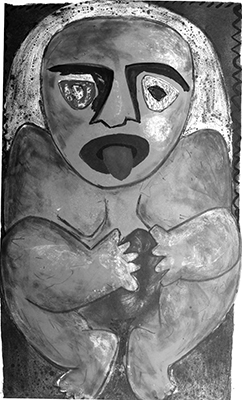Starr Goode
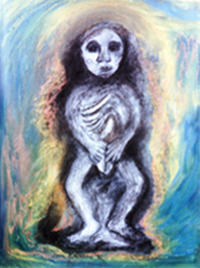

Sheela na gig: The Dark Goddess of Sacred Power
by Starr Goode
Review by Kate Brunner FAR - Feminism and Review December 12, 2017
If there are devotees of the Dark Goddess on your Yuletide gift list, Starr Goode's gorgeous book, Sheela na gig: The Dark Goddess of Sacred Power, may be the best gift you could choose for them.
Goode's connection to the Sheela is profound. Equal parts scholastic study, visual feast, and ardent devotional, this book will take the reader along on the author's epic journey into the Mysteries of the Sheela na gig. As Goode explains thoroughly, there are no written primary source documents illuminating the origins and purposes of the Sheelas that survive today. Scholars and thea/ologians argue about the truth behind Her presence, but no one can yet definitively declare Her history and meaning. However, that does not mean one cannot still study that history as one way of connecting deeply with Her Mysteries today.
Reminiscent of her work on the cable TV series, The Goddess in Art, Goode provides her readers a great deal of well-researched and thoroughly documented material with which to learn about the architectural, artistic, historical, and folkloric background of the medieval Sheelas of the British Isles. Her impeccable scholarship gives one deeper insight into this "visual antinomy of the forces of destruction and creation… a manifestation of the Dark Goddess with the power to renew." (89). After grounding readers in the background knowledge of the medieval Sheelas, Goode takes us on an epic mythological journey, tracing potential Dark Goddess connections back through human history almost as if we are traveling deep within the Sheela, Herself, down all the way into the caves of our Paleolithic ancestresses.
Goode balances this scholastic study with an intimate window into her personal Sheela pilgrimages. Bringing the read with her on her travels, we join Goode as she lives the magic of the Sheela in her narrative and photos, traversing winding roads, chasing reports of relocated Sheelas, and even dodging the occasional bull in a pasture to catch a glimpse of Her. My favorite passages in this section of the book are about the Kiltinan Church Sheela na gig, a unique figure with such importance to Her local community that when She was stolen in 1990, the theft was discovered almost immediately and a reward was offered for any information leading to Her return. By sharing these journeys with us, Goode helps the Sheelas of Ireland, England, and Wales to come alive for us.
Part III explores cross-cultural images of the Dark Goddess that can be visually linked to the power of the Sheela na gig. From east to west, north to south, Goode explores what she calls "the power of display" wielded by ancient Goddess and modern woman, alike. The closing chapters of this section powerfully illustrate the persistent relevance of the Sheela's Mysteries to the resurgence of the Sacred Feminine and our continued quest for sovereignty by collecting together modern works of art and poetry that are deeply inspired by the Sheela.
This is a substantial book, in content and size and one that you must hold in your hands to fully appreciate. Even though it is also available in Kindle format, I recommend a good ole' fashioned hardback copy for this one. It's worth the few extra dollars' investment because there is so much to work with here in not only the written material, but also the plethora of images and a wonderful bibliography that both invite further scholastic and devotional exploration.
Sheela na gig: The Dark Goddess of Sacred Power by Starr Goode is available via Inner Traditions, a Vermont publisher committed to ecological sustainability, for almost the same price as Amazon. So, should you decide to purchase this book for yourself or as a gift, please consider buying it from them.
Kate M. Brunner is a writer, healer, ritualist, and member of The Sisterhood of Avalon. During 2018, she will be presenting at the SOA's annual online conference, AvaCon, as a part of Land, Sea, Sky Travel's "A Year With Our Gods" online conference series, and at the third annual Ninefold Festival in the Colorado Springs area. Kate's work is published in Flower Face: A Devotional Anthology in Honor of Blodeuwedd and The Goddess in America: The Divine Feminine in Cultural Context.
1 2
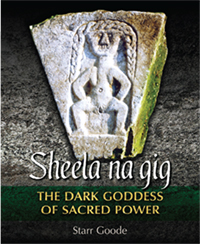
Sheela na gig: The Dark Goddess of Sacred Power by Starr Goode
Synopsis
Traces the origins of the Sheela na gig from Medieval times to Paleolithic cave art
• Reveals the sacred display of the vulva to be a universal archetype and the most enduring image of creativity throughout the world
• Provides meditations on the Sheelas the author encountered in Ireland, England, Scotland, and Wales, allowing readers to commune with the power of these icons
• Includes more than 150 photographs and illustrations from around the world
For millennia, the human imagination has been devoted to the Goddess, so it is hardly a surprise to find images of supernatural females like Sheela na gigs adorning sacred and secular architecture throughout Ireland, England, Wales, and Scotland. Appearing on rural churches, castles, bridges, holy wells, tombs, and standing stones, these powerful images of a figure fearlessly displaying her vulva embody the power of the Dark Goddess over the mysteries of sex, life, death, and rebirth.
Exploring the art and myth of the Sheela na gig from Celtic and Classical times back to Paleolithic cave art, Starr Goode shows how the Sheela embraces a conundrum of opposites: she clearly offers up her ripe sex yet emanates a repelling menace from the upper half of her hag-like body. Through more than 150 photographs, the author shows how the Sheela is a goddess with the power to renew, a folk deity used to help women survive childbirth, and, as a guardian of doorways and castle walls, a liminal entity representing the gateway to the divine. She explains how these powerful images survived eradication during the rise of Christianity and retained their preeminent positions on sacred sites, including medieval churches.
The author provides meditations on the individual Sheelas she encountered during her 25 years of research, allowing readers to commune with these icons and feel the power they emanate. Exploring comparable figures such as Baubo, Medusa, the Neolithic Frog Goddess, and vulva depictions in cave art, she reveals the female sacred display to be a universal archetype, the most enduring image of creativity throughout history, and illustrates how cultures from Africa and Ecuador to India and Australia possess similar images depicting goddesses parting their thighs to reveal sacred powers.
Explaining the role of the Sheela na gig in restoring the Divine Feminine, the author shows the Sheela to be an icon that makes visible the cycles of birth, death, and renewal all humans experience and a necessary antidote to centuries of suppression of the primal power of women, of nature, and of the imagination.
1 2
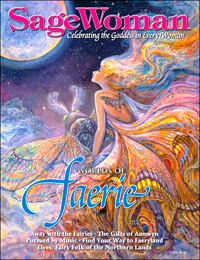
Barbara Ardinger reviews Sheela na gig: The Dark Goddess of Sacred Power
by Starr Goode. Inner Traditions, 2016
True story: I have a small plaque, arched like a church window, that shows a Sheela na gig with a mirror in her sacred space. It hangs above my door to bless my goings-out and my comings-in. Some years ago, a businessman came to see me. Half-way through our conversation, he looked up, saw the Sheela and her mirror, muttered something rude, and began talking a lot faster. As soon as he finished his pitch, he rushed out. He never came back.
The guy's reaction to my little piece of art reflects an old, old theme: men's fear of women's sexuality. As Starr Goode tells us in this gorgeously illustrated book, Sheelas have for millennia adorned churches, castles, bridges, holy wells, tombs, and standing stones throughout the British Isles and in a few European sites. This goddess pulls her labia open to reveal her powers over the mysteries of sex, life, death, and rebirth. Goode was introduced to the Sheelas about 25 years ago by a friend who showed her a photocopy of a photo of the Kilpeck Sheela (the earliest and probably the most familiar image) in a book by a Danish art historian. Since that time, she has traveled (many times, as related in Part II) to the British Isles to study the Sheelas. Today she probably knows more about Sheela na gig than anyone else on the planet. When I told her this in an email, she modestly replied, "I think one of my contributions is to see the universality of female sacred display in it meanings and functions back to the origins of culture (Paleolithic cave art)." Goode has done her homework in writing this book; she refers to and quotes from other scholars. She also critiques the work of some who draw conclusions that seem not to be supported by the evidence of the Sheelas and their settings.
The book is divided into sections on history, Goode's many journeys, and the images. The history (Part I) is especially interesting: (Chapter 1) “Historical Overview: Agreements and Disagreements," (2) “The Sheela as Sin," (3) “Celtic Connection," (4) Medieval Mindset on Pagan Soil," (5) "The Sheela's Classical Forbears," (6) “The Dark Goddess of the Neolithic," and (7) "The Cave Art of the Paleolithic." In Part III, the Images, we learn about (Chapter 10) "The Power of Images," (11) “The Creative Source," (12) "The Return of the Goddess," and (13) "The Secret of the Sheelas." The book has notes, a bibliography, and an index.
What does the name of this enigmatic figure mean? She's been called a hag, a witch, and many other (often insulting) names, but the actual meaning of her name is difficult to trace. It seems to be partly Gaelic, and “possible translations of the name…from the Irish include Sighle na gCioch, meaning ‘old hag of the breasts,' or Sile-ina-Giob, [which may mean] ‘Sheela…on her hunkers,' which well describes the froglike pose of the figure. Or, getting to the gist of the matter, Sile-na-gigh, 'Sheela of the vagina': gigh is slang, not a standard Gaelic term" (pp. 9-10). But there's more. In Chapter 1, which is a review of the literature, Goode gives other theories of the meaning of the name and concludes that “no one knows for sure [what the name means]. However, one can say with certainty that her image survives, and the fascination with the mysterious Sheela na gigs has only continued to grow" (p. 14).
There is in fact so much information about the Sheelas that summarizing the entire book would require a review as long as this whole magazine. We learn, for example, that medieval stone masons may have been amusing themselves or recalling folktales when they began carving grotesque figures. We learn that most of the Sheela were carved during a 500-year period (the Middle Ages). That the Sheela has an important place in the continuity from paganism to Christianity. That in the 18th, 19th, and 20th centuries there were women in Ireland who tried to avert illness, attack, or ill fortune by lifting their skirts to become living Sheelas. That two classical forebears of the Sheela are Baubo and the Gorgon Medusa. And much, much more. Yes, indeed, this book is a treasure house of information. Highly recommended.
1 2
Margaret Merisante reviews Sheela na gig: The Dark Goddess of Sacred Power
by Starr Goode. Inner Traditions, 2016
Margaret Merisante - MythWoman
Right before the historic Women's Marches, I'm thrilled to be celebrating women both present and past, both sacred and “profane,” and through our shared physical selves and our shared sacred heritage. Today, I offer my review of the new book, Sheela Na Gig: The Dark Goddess of Sacred Power by Starr Goode. In Sheela Na Gig, Goode offers an exuberant, well-written, and in-depth study of the peculiar naked sacred female figures as seen above and below. These figures, well-known in the British Isles—especially Ireland, are generally called sheela na gig, Síle Ni Ghig,Sighle na gCioch, or other variants.
Sheela na gig figures plainly and boldly display not only their nudity, but their vulva (typically held open with the sheela na gig’s hands). Indeed, the most common attributes of these figures are that they are 1) female, 2) naked, and 3) have prominent vulvas which are closed, slightly open, or widely parted with the woman’s hands. The fact that these figures adorn churches, temples, castles, doorways, window lintels, grave markers, boundary markers, along with other sacred and communal areas demonstrates not only their divine and earthly importance, but also their celebration of women and female powers.
The females depicted as the sheela show a lovely range of women’s physical and emotional forms: old, young, middle-aged, beautiful, alluring, plain, haggard, fierce, placid, joyful, menacing, pregnant, voluptuous, emaciated or simply scrawny. Refreshingly, none of these figures are “exhibitionist,” “bawdy,” or appear to ever have been made for the patriarchal sexualized gaze. Rather they are iconic, striking, and eminently arresting.
Interestingly, sheela na gigs, both medieval as well as ancient are rendered mainly as sculptures, engravings, or bas-reliefs; less often, as paintings. Goode notes that there some rare examples of wooden sheela na gigs, but the majority of them are created on or out of stone. Clearly, sheela na gigs were meant to last throughout centuries!
Thank goodness that Goode has long been fascinated with sheela na gigs; we now benefit from her comprehensive scholarly journey into their history, symbolism, and sacred associations. While Ireland can boast of retaining the most medieval sheela na gigs of any country, these “sacred display” female figures are quite ancient in other cultures and countries. Goode pictorially and textually traces this section of divine female history from the deep past to the present by presenting the continuum of similar figures (mythological, archaeological, artistic, textual, and symbolic).
The book is very accessible for a general audience with perhaps little to no knowledge of sacred female figures or the ancient history of the divine female. It also offers plenty of juicy detail for readers interested in mythology, archaeology, and goddesses who want to dive further in. Although I would have appreciated a few maps to further orient me on all the locations that sheela na gig figures have been found or still exist as the genius loci, that is a minor quibble. The wealth of photographs and illustrations greatly add to the richness of this book. Divided into three main parts—history, journeys, and image—Goode deftly steers the reader through passages of time, meaning, and locale toward the abundant riches of our shared divine female heritage. Sheela Na Gig is a savory delight from start to finish!
I have the honor of interviewing Starr Goode about Sheela Na Gig next week! Please do look forward to the post of that interview coming soon after. As always, thank-you so much for reading as well as offering your comments either here or on FB.
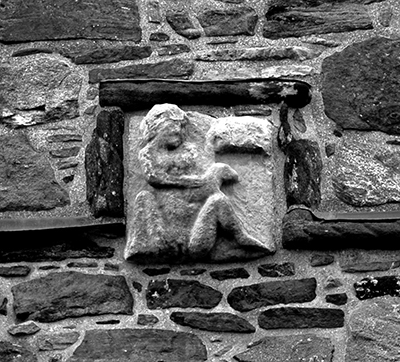
Julie's Bookshelf for Midwest Book Review
Sheela na gig: The Dark Goddess of Sacred Power
by Starr Goode
Inner Traditions International (2016)
http://www.midwestbookreview.com/rbw/jan_17.htm#julie
Synopsis: For millennia, the human imagination has been devoted to the Goddess, so it is hardly a surprise to find images of supernatural females like Sheela na gigs adorning sacred and secular architecture throughout Ireland, England, Wales, and Scotland. Appearing on rural churches, castles, bridges, holy wells, tombs, and standing stones, these powerful images of a figure fearlessly displaying her vulva embody the power of the Dark Goddess over the mysteries of sex, life, death, and rebirth.
Exploring the art and myth of the Sheela na gig from Celtic and Classical times back to Paleolithic cave art, Starr Goode (who teaches writing and literature at Santa Monica College) shows how the Sheela embraces a conundrum of opposites: she clearly offers up her ripe sex yet emanates a repelling menace from the upper half of her hag-like body. Through more than 150 photographs, the author shows how the Sheela is a goddess with the power to renew, a folk deity used to help women survive childbirth, and, as a guardian of doorways and castle walls, a liminal entity representing the gateway to the divine. She explains how these powerful images survived eradication during the rise of Christianity and retained their preeminent positions on sacred sites, including medieval churches.
Starr Goode provides meditations on the individual Sheelas she encountered during her 25 years of research, allowing readers to commune with these icons and feel the power they emanate. Exploring comparable figures such as Baubo, Medusa, the Neolithic Frog Goddess, and vulva depictions in cave art, she reveals the female sacred display to be a universal archetype, the most enduring image of creativity throughout history, and illustrates how cultures from Africa and Ecuador to India and Australia possess similar images depicting goddesses parting their thighs to reveal sacred powers.
Explaining the role of the Sheela na gig in restoring the Divine Feminine, Star Goode shows the Sheela to be an icon that makes visible the cycles of birth, death, and renewal all humans experience and a necessary antidote to centuries of suppression of the primal power of women, of nature, and of the imagination.
Critique: Profusely illustrated with black/white images, "Sheela na gig: The Dark Goddess of Sacred Power" is an exceptionally well researched, impressively informed and informative, deftly organized and presented study that will prove to be of immense interest and value for academia and non-specialist general readers alike. While unreservedly recommended for both community and academic library Metaphysical Studies collections, it should be noted for personal reading lists that "Sheela na gig: The Dark Goddess of Sacred Power" is also available in a Kindle format ($17.99).
Julie Summers, Reviewer
James A. Cox, Editor-in-Chief
Midwest Book Review
278 Orchard Drive
Oregon, WI 53575
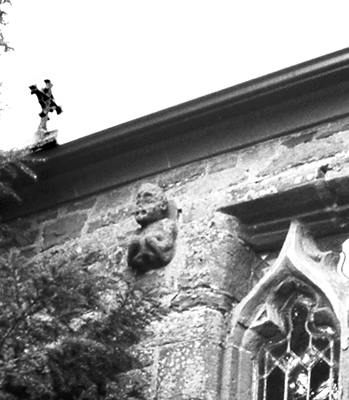
1 2
Sheela na gig, a book by Starr Goode
Saturday, February 18, 2017
Judith Laura, Medusa on Medusa Coils
Sheela na gig: The Dark Goddess of Sacred Power is a large, beautiful book in which the author, Starr Goode, delves into the art, history, and mystery of one of the most sexually assertive and explicit figures honored by those who revere Goddesses and a subject studied by researchers of ancient artifacts. As you might guess from its dimensions, the book is illustration-intensive with a total of 151 excellent black and white illustrations—mostly images—of Sheelas or related deities, such as Baubo. The images come from various time periods (most recently dated back to at least 9600-800 BCE) and various cultures, and can still be seen on churches in the UK, including Ireland. In exploring them Goode, who teaches writing and literature at Santa Monica College and produced and moderated the cable TV series "The Goddess in Art," travels back to the Neolithic and forward to art in our own time. The latter features contemporary interpretations of Sheela. A number of the photos were taken by the author, others are from the work of Marija Gimbutas and from other well-known sources. The seven chapters of Part I, "History," contain 73 illustrations; the two chapters of Part II "Journeys," 30 illustrations; and the four chapters of Part III, "Image," 48 illustrations.
This scholarly book about the "displaying" (holding apart vulva lips) female figure begins with a historical overview that includes agreements and disagreements about Sheelas' origins and significance. Today, there is apparently no agreement on the meaning of Sheela na gig’s name, nor her significance at various times in history, nor even when She first appeared historically. Goode discusses various theories of origin, such as Neolithic, early Pagan, Romanesque, and even later. She includes the role that Romanesque architecture played in the popularization of Sheela representation and the relationship of the transfer of Irish and other goddesses to Christian saints, which resulted in the probable transfer of symbolism that occurred when displaying Sheelas were placed on churches and castles—where many remain today.
In her discussion of Sheela symbolism Goode considers several possibilities, including as "a regenerative symbol for the cycle of life, representing fecundity, decay, and renewal." She writes, "Certainly, the mysteries of sex, death, and rebirth, have accrued around the image of the vulva. It is an open invitation to sex, a birth canal, and, paradoxically, a symbolic return to Mother Earth following death." In Christianity, Goode writes, the displaying figures became "a warning against lust." Later their symbolism became more protective and powerful. One of the strongest and longest associations with Sheelas is "apotropaic" power, in which the displaying female genitals have the power to avert negative influences or bad luck. For example, people used Sheelas to guard against the "evil eye." Related are various titles that have been given to Sheelas by different cultures, such as “Evil Eye Stone” and "the Witch." Citing the German writer Georg Kohl, Goode also discusses "human Sheelas," living women who, in Ireland, were and are still called “Shila na Gigh” and who help people’s luck to change from bad to good by "lifting their skirts to display their female nakedness." Goode also discusses why and when stone Sheelas become less prominent in Ireland, including through their mutilation. Goode explains that in medieval times, Christian clergy considered Sheelas "the devil" and ordered them to be “burned as witches even though they were made of stone, not flesh….in later centuries and to this day, many are being recovered from where they were sometimes tossed into rivers or buried deep beneath castles. Other carvings had their vulvas hacked away...."
In sections on the Sheela's "forebears," the author discusses the relationship of other figures to Sheela, such as Baubo (as in the Demeter-Persephone myth/Eleusinian Mysteries); Medusa; and the Frog Goddess. One of the sections that was especially interesting to me (because I was involved in Eastern European folk dance groups for many years and came to feel that many of them had Pagan and/or Goddess roots), is Goode’s discussion of a Bulgarian women’s ritual with dances related to the Frog Goddess. The dance, which is still done today, is a spring rain dance called Peperouda, While the dance is related to power of frogs, its name is translated “Butterfly” on You Tube videos (butterflies of course also have a springtime association.) I have placed three videos of different (though similar) versions of this ritual dance the end of this review.
Part I of the book also includes a section on “Male Interpretive Bias.” Part II looks more deeply into what Goode learned from her travels to Sheela sites, especially in Ireland and England. Part III focuses on images of Sheelas and deities that resemble Sheela, such as some versions of Kali, and includes contemporary artists’ Sheela interpretations. The back matter includes both Footenotes and Endnotes, plus a Bibiography.
Both the large number of excellent illustrations and the details and depth of Goode’s discussion make Sheela na gig: The Dark Goddess of Sacred Power an extremely valuable book that many Goddess folks and students of the mythology — as well as others — will treasure.

1 2
Additional Reviews from Amazon Customers
Full Frontal Exposure by Harry Reed
If you are a fan of Judy Chicago’s “Dinner Party,” then you will want to get this book! It’s a full frontal exposure of the power of the “dark goddess” hiding right in our midst.
My initiation with Her came many, many years ago, before she was well known by gringos outside the circle of “Jungians.” I had learned of her twin transformative mysteries—alcoholic drunkedness and dream incubation—first hand and marveled at the power of her tough love.
When I gave a lecture on Her at Edgar Cayce’s A.R.E., there was a sell-out crowd. Folks were expecting tales of Mother Mary and other angelic beings, popular representatives of the “Feminine.” The lady I was introducing them too, however, was no Barbie Doll! Even today, when it is even more important than ever that we recognize Her presence and activity, we tend to marginalize Her attributes. Seeing the statues the author has uncovered in Western Europe (birthplace of gringo mentality) is a shock. This dark goddess is not bashful about her stuff. She displays it proudly as if it were her coat of arms. What is the secret of her power? Sexuality, death and rebirth. What does it mean that such a “Spiritual Divine Being” shoves her stuff in our face? Not the usual role model.
What gives this book special value, beyond the author’s discovery of this lost part of our heritage and the immense collection of photographs, is that she uses this discovery of our forgotten psychic DNA to invite us to an alternative mode of consciousness, one that would provide us with a more sustainable lifestyle. I’m not going to try to explain it, you’ll need to read the book!
1 2
A Great Inspirational Book
All the photos of sheelas from all over the world are fabulous! A very interesting concept and clear writing that takes the converstion on Sheela to a new level. A great inspirational book.
1 2
A Timely and Scholarly Study
This is a wonderful, healing, beautifully written, very informative and scholarly book.
